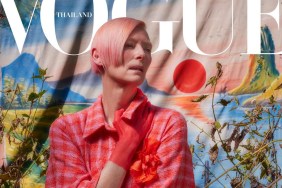Just yesterday, curve model Barbie Ferreira, postergirl for the fashion industry’s body-positive movement, spoke out about the horrid bullying she experiences behind the scenes re: her stretch marks and other physical “flaws.” She revealed that the culprits are often her plus clients, brands that explicitly promote themselves as accepting of all shapes and sizes. In a recent roundtable discussion at the Business of Fashion Voices event, models Joan Smalls and Hari Nef shared parallel stories of the discrimination they’ve faced in their careers.
Smalls, who’s Puerto Rican, is currently the eighth highest-paid model in the world, according to Forbes. (She’s one of the three models of color to make the esteemed 20-name list, we might add.) In 2011, she became the first Latina model to land a contract with Estée Lauder cosmetics. In the past year, she’s fronted three magazine covers — Harper’s Bazaar Spain, Numéro, Glamour US — solo. Even so, the Victoria’s Secret Angel has yet to ink a hair deal. “I’ve always had a struggle trying to get a hair campaign. It’s mind-boggling. I’ve been on option, and they dropped me at the last minute. And the excuse was, ‘We were afraid to try something new.’ And by ‘new,’ they meant ‘We’ve never shot a black girl,’” Smalls elucidated. She’s also been hired for campaigns based, ostensibly, on the color of her skin, then excluded from shots intended for white populations. “For campaigns, it’s like, ‘Okay, Joan’ll do this region, but in the group shot, Joan, you are excluded because you don’t sell, you don’t fit in that quota,’” she shared.
Transgender model-actress Hari Nef is — it practically goes without saying — no stranger to this sort of tokenism. As the first transgender person to sign with IMG and a Vogue favorite, the model gets her share of work. (She landed four magazine covers in 2016, but shared three of them.) That said, like Ferreira, she finds fashion’s commitment to diversity frustratingly calculating. “There’s this subdivision of fashion bookings which also fetishizes diversity as an end. It’s not like you can just be a model — you have to be a trans model, or a black model, or a Latina model. They kind of bring you in and it’s like Diversity Day,” she told the crowd at BoF Voices. “Diversity Day is cool; Diversity Day essentially pays my bills. But it’s never a blue-chip campaign. It’s never a contract, or rarely a contract. Sometimes it’s like a social-media thing. It never really bridges the gap between the hyper-rarefied space of a top booking and just throwing this nominal diversity in so the brand can say they did it.” (Nike’s #Brahaus initiative is just one example of this sort of thing.)
We said it yesterday and we’ll say it again: while diverse imagery and castings do count for something, Ferreira, Smalls and Nef’s firsthand accounts of the fashion and beauty industries’ ongoing prejudices are an important reminder that statistics don’t tell the full story. Even if you don’t have time to sit down and watch the full 24-minute discussion, we highly recommend listening to it podcast-style while you work, commute or hit the gym today. It’s truly eye-opening.
[ via the Cut ]









